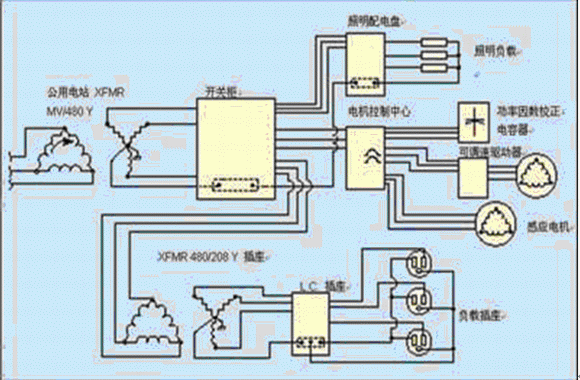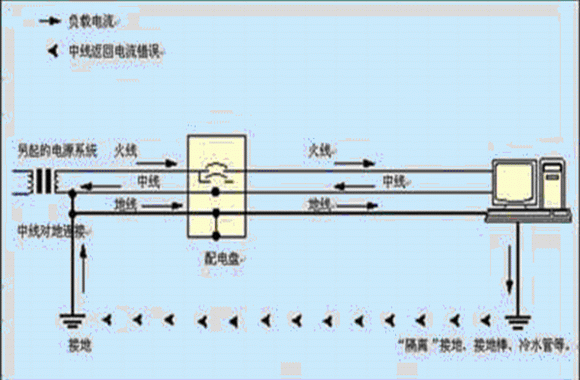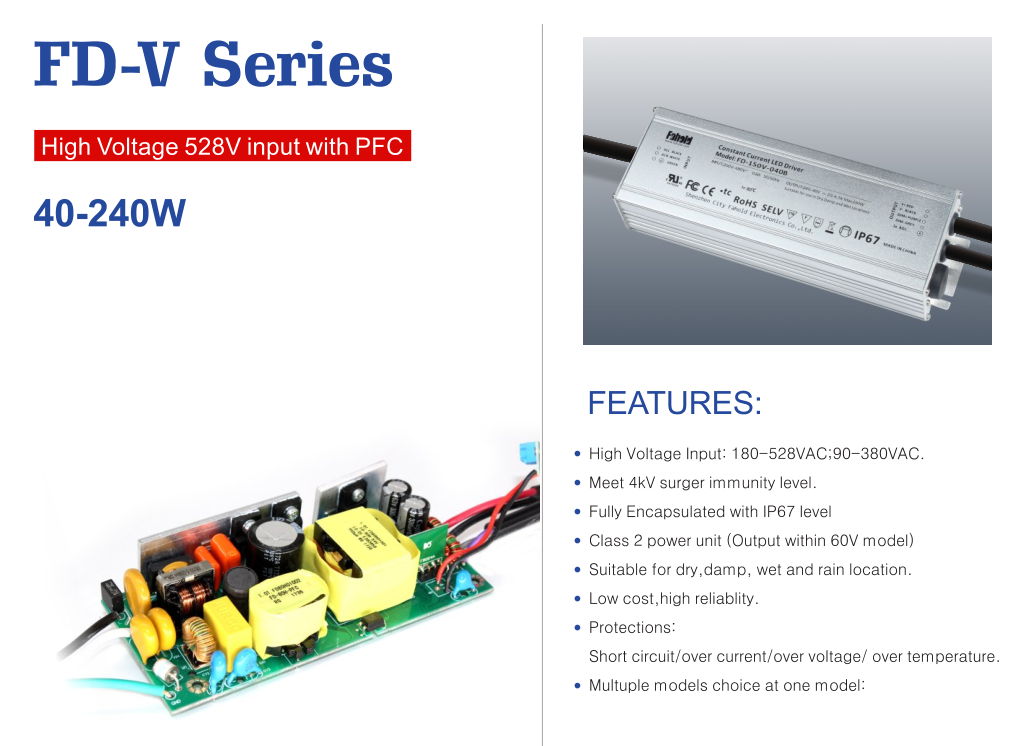Basic power quality measurement methods and causes of common problems
Although we enjoy the huge benefits brought by the development of solid-state technology, in fact, the microelectronics technology at the core of this technology relies on clean electrical energy. Faster speeds and lower voltages mean higher requirements for power quality. Power quality (PQ) involves a wide range, from voltage disturbances such as voltage sags, swells, interruptions and transients, to current harmonics and high-performance wiring and grounding. Symptoms of poor power quality include intermittent locking and resetting of equipment, data corruption, early failure of equipment, and overheating of components without any apparent cause. The end result is interrupted production, reduced productivity, and compromised personnel.
One way to check and troubleshoot power quality problems from the problem site is to start the inspection as close to the affected load as possible. The affected load is a sensitive load with abnormal function, usually an electronic load. When suspecting a power quality problem, part of the work required is to isolate the cause of the power quality problem from other possible causes (hardware, software). This bottom-up approach will be rewarding for you. This requires a keen eye and some basic measurements.
Another method is to use a three-phase monitor to start the inspection from the power inlet and gradually find the affected load. This method is very useful if the problem originates in a public power station. However, repeated investigations have concluded that the vast majority of power quality problems are in facilities. In fact, as a general rule, power quality is the best at the incoming power line (where it is connected to utility power) and deteriorates as it moves downstream in the distribution system. This is because the load of the facility itself causes problems. Another obvious fact is that 75% of power quality problems are related to wiring and grounding problems!
Therefore, many power quality management agencies recommend that a reasonable troubleshooting process is to first diagnose the electrical infrastructure in the building and then monitor if necessary. Our bottom-up troubleshooting steps can help you complete this investigation.
The first step is to make a road map. If you do n’t understand the situation of the location under investigation, it is difficult to diagnose power quality problems. At the beginning, you can first determine the location, or rebuild a one-line diagram of the scene. Through this one-line diagram, you can identify the AC power supply and the load they supply. The actual structured single line diagram with red lines is the single line diagram you want.
If you are working on-site, the wiring diagram may already be in your mind, but if you draw it on paper, it will bring great help to everyone (including yourself). If this is the first time you have come to the work site, getting an up-to-date one-line diagram means you can identify new loads or the latest changes in the system. Why should such efforts be made? Because the systems are dynamic, they will change over time, and these changes are often unplanned and happen arbitrarily. Moreover, although some problems are local in cause and effect, there are also many problems stemming from the interaction between one part and another part of the system. Your job is to understand the interaction of these systems. The more complete your records are archived, the better the results will be.

Figure 1 Typical simplified distribution system in commercial and industrial facilities.
But in reality, the places that need help most often are those that are least likely to have a good record of what happened in the system. Many consultants will play their role by updating the documents submitted to them with the actual conditions on site. The simplest rule is that at this moment in the investigation, records should be archived as much as possible, but do not expect it to be usable.
Go around the work place Sometimes, visual inspection will provide direct clues, you can find the following problems:
â— The transformer has overheated
â— The cable or connector is discolored due to heat
â— The power boards are plugged together
â— Signal cables and power cables are arranged in the same cable bridge
â— There is an additional neutral ground connection in the sub-distribution board
â— The grounding wire is connected to the metal pipe cut off in midair
At least, you will know how the facility is wired and what the typical load is.
Meet with the affected person and keep a record of the incident with the person operating the affected equipment. You will get a description of the problem and often find clues that are not expected. It is also a good practice to record when the problem occurred and the symptoms of the problem. This is extremely important for intermittent problems. The goal is to find a form that helps correlate the problems that occur in the affected load with an event that occurs simultaneously elsewhere. Of course, it is the responsibility of the operator closest to the affected equipment to make such a fault record.
The main causes of power quality problems are caused by a variety of reasons, including natural factors and human errors. The following are some of the main causes of power quality problems.
If lightning is not installed with suitable lightning protection devices, lightning will bring great damage. If the transmission line of the public power station is very long, lightning can also cause voltage sags and undervoltages on the line. If the distance is very close, it will cause voltage swell and overvoltage. In short, lightning is a natural effect, and its destructive effect does not belong to the same category as the damage that humans bring to itself.
The reclosing of automatic circuit breakers in public power stations causes short-term voltage dips / interruptions, but the situation is better than longer-term voltage interruptions.
The breaking of the power capacitor causes high energy voltage interference (like an oscillating transient present on the waveform). If the capacitor bank is near the facility, this transient may propagate throughout the building.
Commercial buildings that do not have enough distribution transformers try to take shortcuts in the wrong place; placing the 208V feeder all the way up to a height of 20 floors will not bring good power quality.
The specifications of the generator set and the harmonic load do not match. Excessive voltage distortion will affect the electronic control circuit. If there is an SCR converter load, harmonics may affect the frequency control circuit. It is incompatible to use power factor correction capacitors without considering harmonic effects. Capacitors are overwhelmed by harmonic loads.
If the inrush current from the high torque direct pressurized starter motor load is too large or the power supply impedance is too high, it will cause a sudden voltage drop. Staggered motor starting will help.
The centerline specification on the switchboard is insufficient. In an environment full of third harmonics, the centerline easily carries currents that are equal to or much higher than the phase currents. Insufficient specifications of the neutral conductor will cause overheated terminals, potential fire hazard, and high neutral-to-earth voltage.
Arranging the power line and the signal line together can treat the signal line as the secondary of the single-line transformer, and the power line as the primary of the transformer. There is always an opportunity for coupling between them.
Loose conduit joints and lack of green ground wire cause the ground loop to break or high impedance. This is detrimental to power quality or safety.
Socket wiring error (replacement of neutral and ground)
It's hard to believe, but there are many cases. The return current is added to the ground wire and generates ground noise current.
Each end of the data cable is connected to a different ground reference This is amazing! Indicates that there is a voltage between the device housing and the data cable connector.
The most effective high-frequency grounding technique for high-frequency noise is to install a signal reference grid (SRG).
Isolating ground rods is a safety hazard because ground is a high-impedance circuit that will prevent enough current from flowing to trip the circuit breaker. They also create ground loops; after all, every electron must return to where they came from. For power quality considerations, some manufacturers will insist on the view that unless an isolation ground rod is installed, the equipment warranty they provide is invalid.
Illegal neutral to ground connection

Figure 2 Isolating ground rods can produce ground loops, common problems in CNC machine tools
Add the return current to the ground wire. This is not only a power quality issue, it is also a pipeline issue. The circulating ground current will corrode the water pipe.
In addition to those listed above, there are many other reasons. For example, the presence of a common neutral on the branch circuit will cause load interaction and neutral overload; laser printers and copy machines that share the branch circuit with sensitive loads have periodic voltage dips and switches Transient etc.
IP65 Rated Aluminum LED Driver
Top features include:
- Constant Voltage or Constant Current modes
- Protection: Short circuit / Over-voltage / Over-temperature
- High Efficiencies: Up to 92%
- IP65 and IP67 designs for dry, damp or wet locations
- Fanless design: Cooling by free-air convection
- UL Cdertified for US and Canada; FCC Class B
- 5 year warranty!
Multiple Options Available for Each Model
- A-type: IP65 rated; Round high Bay Driver, Constant current level can be adjusted through internal potentiometer
- B-type: IP67 rated and built-in 3-in-one dimming function (0-10Vdc, PWM signal or resistance)

High Voltage Input LED Driver,480V industrial High Voltage Driver,LED Driver High-bay Environments Application,IP67 LED Drivers
ShenZhen Fahold Electronic Limited , https://www.fahold.net